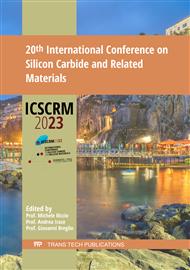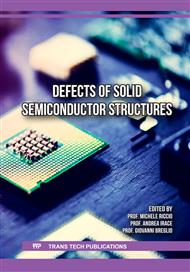p.81
p.87
p.93
p.99
p.105
p.111
p.117
p.123
p.129
Investigation of BPD Faulting under Extreme Carrier Injection in Room vs High Temperature Implanted 3.3kV SiC MOSFETs
Abstract:
Implantation process for high Al dose p+ contact layers in SiC MOSFETs can generate new basal plane dislocations (BPDs). Such BPD faulting under high carrier injection was investigated in SiC MOSFET layers designed for 3.3kV operation with either room temperature (RT) or high temperature (HT) implantations performed for their high dose p+ contact layer. For excess carrier injection levels of ~1x1018 cm-3 implant induced BPDs faulted from the termination regions of the MOSFETs in the case of RT samples, while the HT samples show no BPD faulting because there were no implant-induced BPDs. However, in the active region of the device no BPDs faulted for both the RT as well as HT samples even at a higher carrier injection of ~1x1019 cm-3. Technology computer-aided design (TCAD) simulations show that the lower doped p-well region below the p+ contact in the active area of the device prevents the minority electron density in the p+ contact layer to below 10x the hole density, which limits BPD faulting even when they are present in that layer as in the case of RT implanted samples.
Info:
Periodical:
Pages:
105-110
Citation:
Online since:
August 2024
Permissions:
Share:
Citation:



